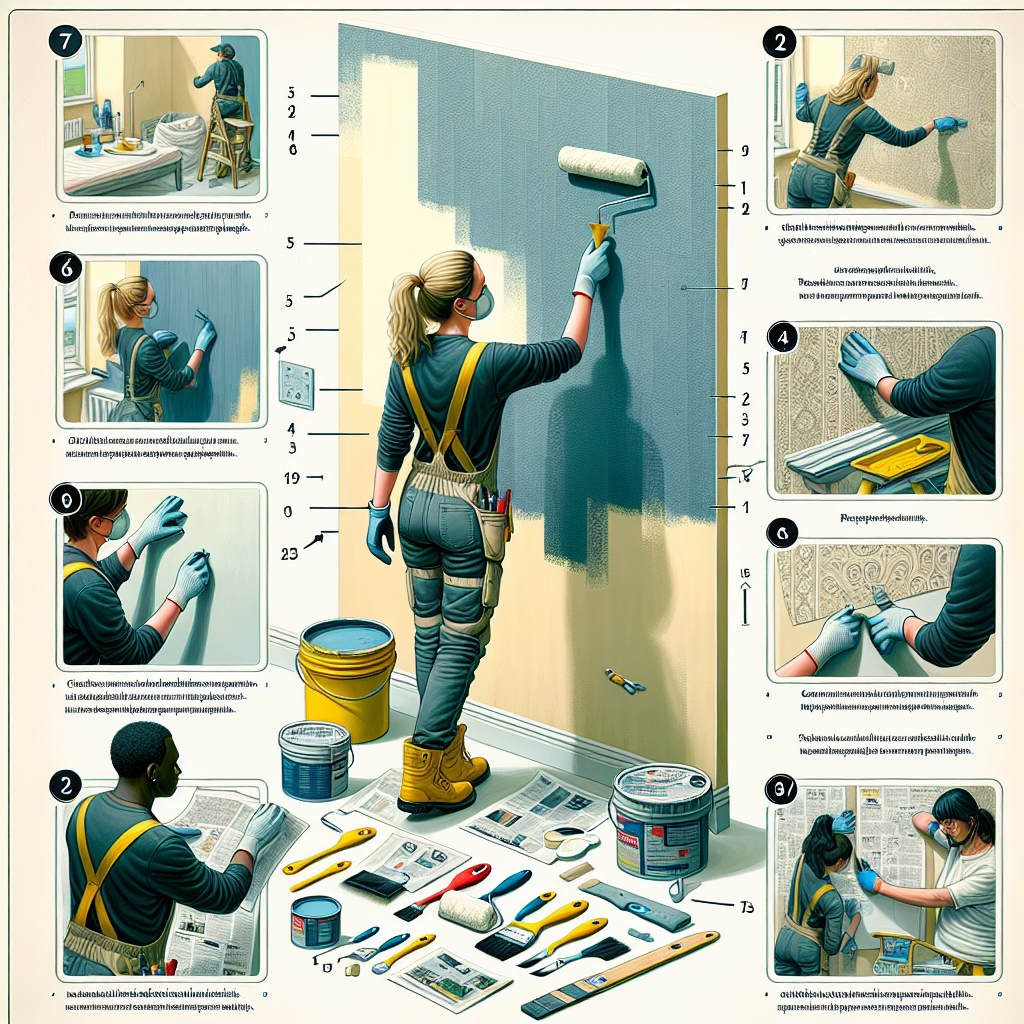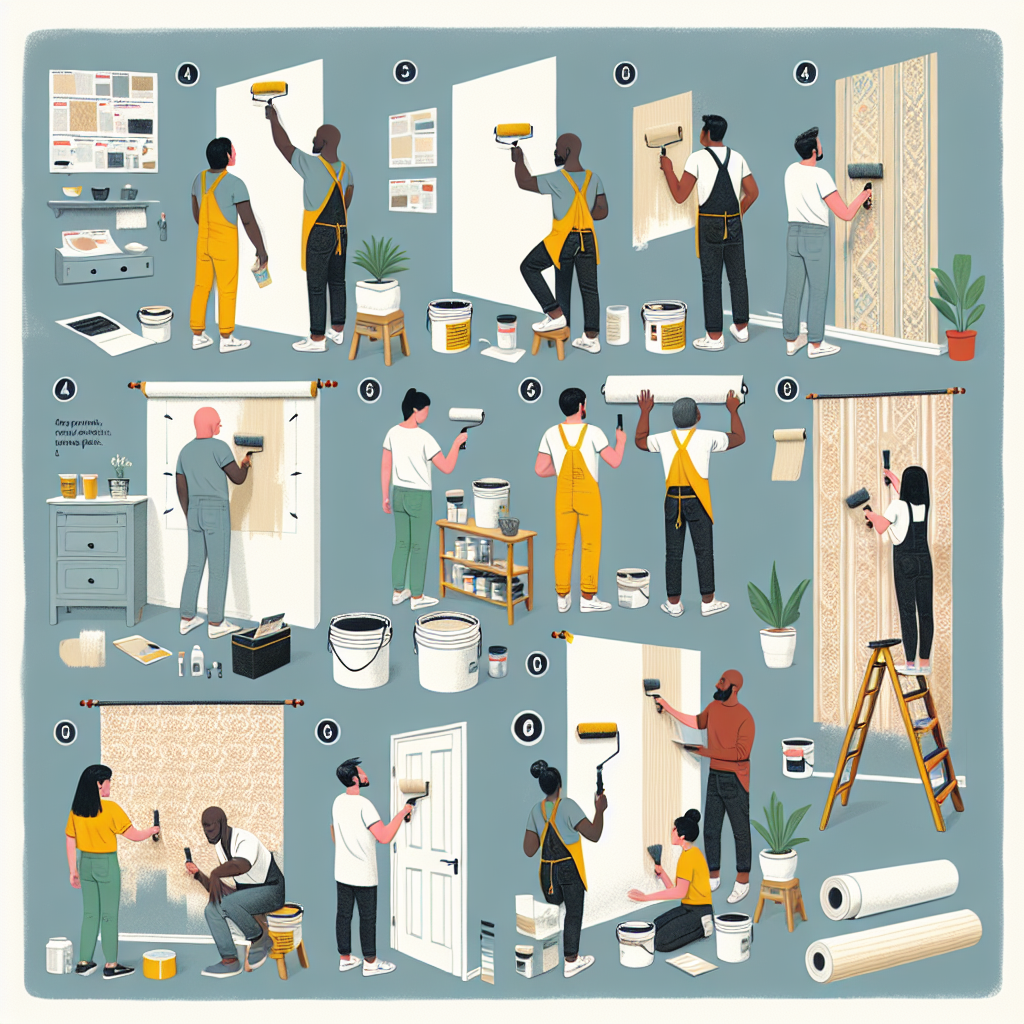DIY Techniques for Applying Wall Paint and Wallpaper

When it comes to transforming the look and feel of a room, few things have as much impact as a fresh coat of paint or a stylish wallpaper. Whether you’re looking to add a pop of color or create a statement wall, knowing the right techniques for applying wall paint and wallpaper can make all the difference. In this article, we will explore various DIY techniques that will help you achieve professional-looking results. From prepping the walls to choosing the right tools and materials, we’ve got you covered.
Preparation is Key
Before diving into the application process, it’s crucial to prepare your walls properly. This step ensures a smooth and long-lasting finish. Here are some essential preparation techniques:
1. Clean the Walls
Start by removing any dirt, dust, or grease from the walls. Use a mild detergent and warm water solution to gently scrub the surface. Rinse with clean water and allow the walls to dry completely before proceeding.
2. Repair Any Damage
Inspect the walls for any cracks, holes, or imperfections. Fill these areas with spackling compound or putty, and smooth them out with a putty knife. Once dry, sand the patched areas until they are flush with the wall surface.
3. Sand the Walls
Even if your walls appear smooth, it’s a good idea to lightly sand them to create a better surface for paint or wallpaper adhesion. Use a fine-grit sandpaper and sand in a circular motion. Wipe away the dust with a damp cloth.
Applying Wall Paint
Painting a room can be a fun and rewarding DIY project. Here are some techniques to help you achieve a professional finish:
1. Choose the Right Paint
Consider the type of paint that suits your needs. Latex paint is popular for its easy cleanup and low odor, while oil-based paint provides a more durable finish. Additionally, select the appropriate sheen for your desired look, such as matte, eggshell, satin, or semi-gloss.
2. Use Primer
Applying a coat of primer before painting can improve the adhesion of the paint and provide a more even finish. It also helps to cover any stains or dark colors on the walls. Choose a primer that is compatible with your paint type and follow the manufacturer’s instructions for application.
3. Cut In Before Rolling
Start by cutting in the edges of the walls using a brush or a small roller. This technique involves painting a narrow strip along the corners, ceiling, and baseboards before using a larger roller for the main wall areas. Cutting in ensures a clean and precise finish.
4. Roll in Sections
When using a roller, divide the wall into manageable sections. Start from the top corner of a section and roll the paint in a “W” or “M” shape. Then, fill in the shape with vertical strokes. This technique helps to distribute the paint evenly and avoid visible roller marks.
5. Apply Multiple Coats
In most cases, a single coat of paint is not enough to achieve full coverage. Allow each coat to dry completely before applying the next. Two or three coats are typically recommended for a professional-looking finish. Follow the paint manufacturer’s instructions for drying times.
Applying Wallpaper
Wallpaper can add texture, pattern, and personality to a room. Here are some techniques to help you successfully apply wallpaper:
1. Measure and Cut
Measure the height of your walls and add a few extra inches to allow for trimming. Cut the wallpaper into manageable lengths, ensuring the pattern matches if applicable. Use a straight edge and a sharp utility knife for precise cuts.
2. Mix the Wallpaper Paste
If your wallpaper requires paste, follow the manufacturer’s instructions to mix it to the right consistency. Use a clean bucket and stir the paste thoroughly to avoid lumps. Let the paste sit for a few minutes before applying it to the wallpaper.
3. Apply the Paste
Using a paint roller or a wallpaper brush, apply an even layer of paste to the back of the wallpaper. Be careful not to oversaturate the paper, as it may cause it to tear or warp. Fold the pasted sections together, known as “booking,” and let it sit for the recommended time.
4. Hang the Wallpaper
Starting from a corner, carefully position the top of the wallpaper against the wall. Smooth it out with a wallpaper brush or a plastic smoother, working from the center to the edges to remove any air bubbles or wrinkles. Trim any excess wallpaper at the top and bottom.
5. Match the Patterns
If your wallpaper has a pattern, it’s essential to match it correctly. Take your time to align the patterns precisely, ensuring a seamless look. Use a straight edge and a sharp knife to trim the edges neatly.
Frequently Asked Questions about “DIY Techniques for Applying Wall Paint and Wallpaper”
1. Can I paint over wallpaper?
While it is possible to paint over wallpaper, it is generally not recommended. The texture and seams of the wallpaper may show through the paint, resulting in an uneven finish. It is best to remove the wallpaper before painting for a smoother result.
2. How do I remove wallpaper?
Removing wallpaper can be a time-consuming process, but it is necessary for a clean surface. Start by scoring the wallpaper with a scoring tool to allow the removal solution to penetrate. Apply a wallpaper removal solution or a mixture of warm water and fabric softener to loosen the adhesive. Gently peel off the wallpaper using a putty knife or a wallpaper scraper.
3. Can I paint directly on a textured wall?
Painting directly on a textured wall is possible, but it may require more paint and effort to achieve full coverage. The texture may also affect the final appearance of the paint. Consider using a textured paint or applying a skim coat to create a smoother surface before painting.
4. How long does it take for paint to dry?
The drying time of paint depends on various factors, including the type of paint, humidity, and temperature. In general, latex paint dries to the touch within one to two hours, while oil-based paint may take up to eight hours. However, it is recommended to wait at least 24 hours before applying a second coat.
5. Can I wallpaper over painted walls?
Yes, you can wallpaper over painted walls. However, it is important to ensure that the paint is in good condition and properly adhered to the wall. Lightly sand the painted surface to create a better bond for the wallpaper adhesive. Applying a primer before wallpapering can also improve adhesion.
Summary
Transforming your walls with paint or wallpaper is a rewarding DIY project that can breathe new life into any room. By following the proper techniques and taking the time to prepare your walls, you can achieve professional-looking results. Remember to clean, repair, and sand the walls before applying paint or wallpaper. When painting, choose the right paint, use primer, cut in before rolling, roll in sections, and apply multiple coats. For wallpaper application, measure and cut accurately, mix the paste correctly, apply the paste evenly, hang the wallpaper carefully, and match the patterns precisely. With these techniques, you’ll be able to create a stunning and personalized space that reflects your style and creativity.
For more information on DIY techniques for applying wall paint and wallpaper, visit North Bay Contractors.

